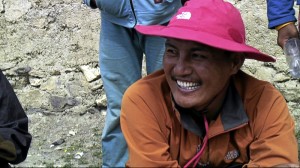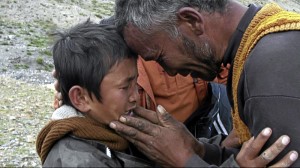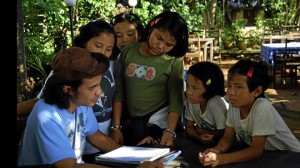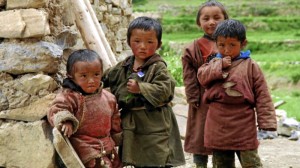‘Waking Journey’ continues to inspire
A film on an inspiring voyage is going places. Ferdinand John Balanag’s documentary, “Walking the Waking Journey,” which debuted two years ago at Cinemalaya, has been invited to three film festivals in the United States.
The docu follows the perilous trek made by Tibetan monk Lama Tenzin and the children that he is returning to their remote Himalayan villages seven years after he rescued them from poverty.
First stop for the movie is the first Silent River Film Festival in Irvine, California, ongoing until September 16. It will next be shown at the 11th Kansas International Film Festival in Overland Park, Kansas, September 30 to October 6.
It will also be screened at the International Film Festival of Manhattan, to be held in New York City from November 11 to 17.
“I’m elated and excited,” said Balanag of the three invitations. “This is the continuing journey of not just the film, but of Lama Tenzin and the Tibetan children. The journey continues as the story reaches out to more people.”
Balanag, who plans to attend the festivals, hopes the monk will be able to grace the events as well. “Lama Tenzin has just returned from another trek to Upper Dolpo, where he rescued a crippled young girl,” Balanag related. “I’m sure he’s very happy that the docu is catching attention. He understands that these are special opportunities to touch more hearts.”
Last year, “Waking Journey” won the Golden Ace Award at the Las Vegas Film Festival.
The Baguio City-based filmmaker pointed out, “I’m keeping my commitment… which goes beyond the prestige and glamour that come with film festivals.” Even the children in the movie, he said, have remained focused on their mission. They are studying in India so they can eventually help their villages.
Before embarking on yet another expedition, Balanag visited the Inquirer to screen the docu and answer questions on his own “waking journey.”
Why do you think you were led to this docu?
I discussed this with the monk and the producers— they said an invisible hand pulled me out of the Philippines to join them.
US-based producers Sheila Neubauer and Ilonka Harezi told me that it was difficult to find a crew because of the danger—and the Maoist rebels. Americans would stand out, so they got an Asian crew who would blend in.
(He traveled with cinematographers Regiben O. Romana and Jordan Arabejo and production assistant Pusongbughaw Romana.)
We were the first Filipinos to go there bringing cameras.
How do you process the idea of going to the Himalayas? Did you just say yes?
Immediately. I was at a very low point in my life, questioning myself, worried about my career.
Was there a point when you almost quit?
There were times I asked myself what I was doing, why I took it on. It was really difficult; we (the crew) also had to go on a fast with the monk and the children.
Aside from tenacity, what did you learn from the children?
Usually, we say it takes a village to raise a child. But, in this instance, it’s the children who are working to raise the village.
Of course, the children live by the basic principles of Buddhism: love and compassion, tolerance, humility and forgiveness.
They are being raised following traditional spiritual methods and sent to formal schooling at the same time. The monks are preparing them to be future leaders.
Are you in touch with Lama Tenzin?
Yes, he’s become such a techie. He has learned to use Skype. He’s on Facebook, too.
He was in Manila for the Cinemalaya premiere, right?
Yes. He also went to Baguio.
What was his reaction, watching the film with the audience at CCP?
He has a very strong presence. When he shared his experiences, the people were stunned and listened closely. After the screening, you could see that he was proud; it was an achievement for him. More than that, he was happy that he was able to fulfill his promise to the children.
Did you have a script?
None. I knew the basic premise. That it was a trek. I just kept a daily journal, which became the basis for the script.
What were your conversations with Lama Tenzin like?
We had very deep conversations. He became a good friend. He gave me a Tibetan name… his own name, Tenzin, which means “defender of the faith.” They say it’s a significant act to give one’s name to somebody else.
Wasn’t he going beyond his faith in helping the children?
Yes. He belongs to the Kagyu sect; traditionally, they are required to stay in the monastery, to chant and meditate all day. But he’s an activist. He believes that faith should propel people into action. You cannot just remain compassionate and not do anything. He’s radical that way.
Have you been on a trek like this before?
Yes, to Mount Pulag in the Cordilleras. I used to help [filmmaker] Kidlat Tahimik conduct workshops in the interiors. But a Pulag trek is just four hours. In the Himalayas, it took us six to 10 hours a day… for 30 days.
Isn’t there a shortcut?
There is a shorter route but it goes through China. The road is blocked, plus we have to trek slowly because there were children with us.
How did the docu affect Lama Tenzin?
It sort of propelled a fundraising campaign for his projects. It had a ripple effect. I hope that, after watching the film, people will be moved into action.
Is it okay to just give donations instead of joining the next trek?
We keep it to a minimum. Food supplies are heavy. More people means more equipment and more supplies.
What was the hardest part of the trek in the docu?
I had to carry one of the boys, Samdup, on my back. He suffered altitude sickness. He passed out and was freezing.
What is it like to suffer hypothermia?
The headaches are intense. You hallucinate. I thought a bird was following us.
How many hours of footage did you shoot?
About 72 hours. We have so much unused material: Hindu ceremonies, temples, villages, everyday life. We have enough for another docu.
How soon are you going back?
We’re awaiting confirmation from Lama Tenzin. We have to consider the weather, the children’s health and, of course, funding. He wants to bring another set of children—those who were too young to make the first trip.
Knowing him… he’s unstoppable. We call him Lama Go-Go!
Photos courtesy of Ferdinand John Balanag




